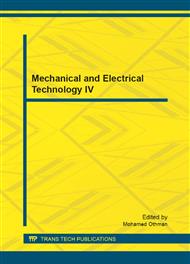[1]
R.K. Thakur, Ch. Vial, K.D.P. Nigam, E.B. Nauman and G. Djelveh, Trans IChemE, Vol. 81, Part A (2003) p.787.
Google Scholar
[2]
K. J. Myers, A. Bakker, D. Ryan, Chem. Eng. Pro., Vol. 93 (6) (1997) p.28.
Google Scholar
[3]
S. H. Wong, M.C.L. Ward, C.W. Wharton, Sensors and Actuators B 100 (2004) p.359.
Google Scholar
[4]
S.J. Wang, S. Devahastin, A.S. Mujumdar, Applied Thermal Engineering, Vol. 26 (2006) p.519.
Google Scholar
[5]
S.M. Hosseinalipour, A.S. Mujumdar, Int. Comm. Heat and Mass Transfer, Vol. 24 (1997) p.27.
Google Scholar
[6]
S.M. Hosseinalipour, A.S. Mujumdar, Int. Comm Heat and Mass Transfer, Vol. 24 (1997) p.39.
Google Scholar
[7]
S.M. Hosseinalipour, A.S. Mujumdar, Numerical Heat Transfer, Part A, Vol. 28 (1995) p.647.
Google Scholar
[8]
D. Gobby, P. Angeli, A. Gavriilidis, J. Micromech. and Microeng., Vol. 11 (2001) p.126.
Google Scholar
[9]
A. Soleymani, H. Yousefi, I. Turunen, Chem. Eng. Science, Vol. 63 (2008) p.5291.
Google Scholar
[10]
M.A. Delavar, ASME proceeding of International Conference on Physics Science and Technology (ICPST 2011), Dubai (2011) p.55.
Google Scholar
[11]
H.J. Sung, S.Y. Kim, J.M. Hyun, Int. J. Heat Fluid Flow, Vol. 16 (1995) p.527.
Google Scholar
[12]
S. CHikh, A. Boumedien, K. Bouhadef, G. Lauriat, Num. Heat Trans. A, Vol. 28 (1995) p.707.
Google Scholar
[13]
A. Bejan, in: Advanced engineering thermodynamics, 2nd Ed. NY, Wiley (1997).
Google Scholar
[14]
P. Yuan, H.S. Kou, Numerical Heat Transfer, Part A, Vol. 43 (2003) p.619.
Google Scholar
[15]
S. Al"boud-saouli, N. Settou, S. Saouli, N. Mezrab, Applied Energy, 84 (2007) p.279.
Google Scholar
[16]
M.A. Delavar, M, Farhadi, K. Sedighi, Heat Transfer Research, Vol. 40 (2009) p.521.
Google Scholar
[17]
M.A. Delavar, M, Farhadi, K. Sedighi, Thermal Science, Vol. 15 (2) (2011) p.423.
Google Scholar
[18]
A.A. Mohammad, in: Lattice Boltzmann Method, Fundamentals and Engineering Applications with Computer Codes, Springer, London, England (2011).
Google Scholar
[19]
T. Seta, E. Takegoshi, K. Kiatano, K. Okui, J. Thermal Sci. Tech., Vol. 1 (2006) p.90.
Google Scholar
[20]
S. Ergun, Chem. Eng. Prog., Vol. 48, (1952) p.89.
Google Scholar
[21]
P.X. Jiang, X. C Lu, Int. J. Heat and Mass Transfer, Vol. 49 (2006) p.1685.
Google Scholar
[22]
B. Alazmi, K. Vafai, Int. J. Heat and Mass Transfer, Vol. 44 (2001) p.1735.
Google Scholar


